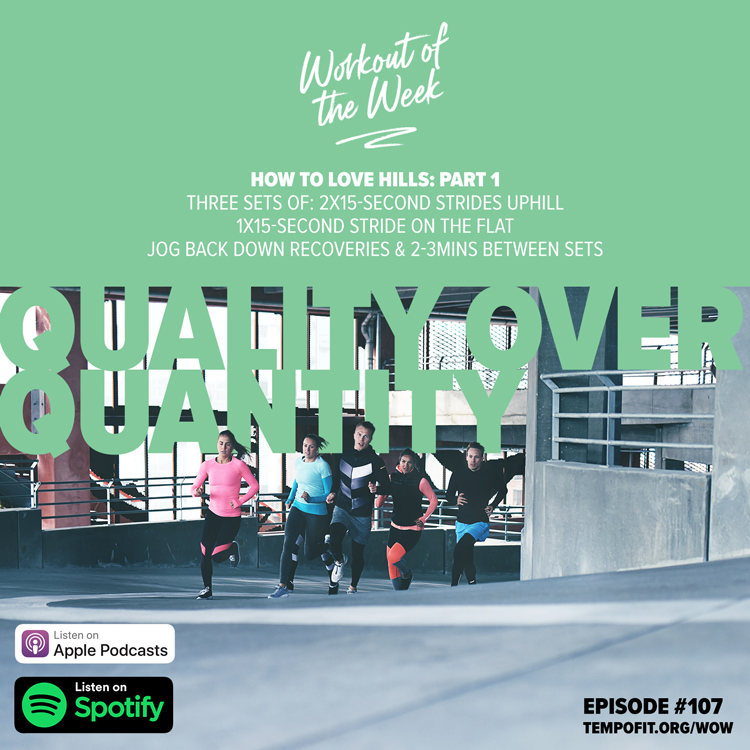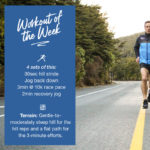
For the next four weeks, come on a journey to discover a new love for running hills! We’ll be doing short, sharp hill reps with plenty of recovery to develop technique, power and overall improve our emotional relationships with going vertical!
WHAT?
HOW TO LOVE HILLS: PART 1
3 sets of:
2×15-second strides uphill
1×15-second stride on the flat
Jog backdown recoveries and at least 2-3mins between sets
Terrain: Mild-to-moderate hill with a flat section nearby.
You don’t just get good at running hills by doing massive 3 to 5-minute hill reps. Instead, you can focus on quality over quantity in order to be fresh for every rep, dial in the technique and recruit every muscle fibre possible.
Remember, “strides” are shorthand for “fast, controlled bursts of running”. They’re not sprints and should stay at the upper end of your running spectrum, but not feeling like you’re being chased by a tiger.
WHY?
This relatively short workout is short in order to be very intentional in getting your body (and mind) moving well uphill.
In a fresh state, your central nervous system is far more able to coordinate your movements and to learn make them more efficient.
HOW?
The recovery jogs back down the hill should be super light and feel free to take more time between strides if needed. Likewise, make the recovery jogs between sets nice and long to feel fully recovered before the next set.
The location for this session is important. For those new to hill running, find a mild gradient (somewhere between 3-5%). And for those who have been following the last couple of weeks of fartlek training with us, you’ll be fine to tackle something more moderate (like 6-10%).
Finally, this workout is much lighter than the typical session we do in Workout of the Week, so we’d encourage the regulars to include an additional session in your week of 6×3-minute fartlek (with 2min jogs) at a pace of your choosing just to keep the engine humming (avoid any nasty hills though!).
THOUGHTS FOR THE WEEK:
HAVE A KEY SESSION EACH WEEK
By Hayden Shearman
Many runners have a very vanilla look to their training where every run looks the same and there isn’t the opportunity for growth into a particular area. Instead, our training weeks can benefit from having one session each week that operates as the focus for that week, with every other workout either building towards that session or recovering from it.
Here are some ideas to incorporate a key session each week in your training.
What does a key session look like? This is going to be different for everyone and will change throughout the year. In the off-season, your long run might be the key session. When you’re close to a race, a race-pace workout will be the key session. And, other times, like in this Workout of the Week, the key session will be about developing a particular strength/weakness (in our case, that’s hill running). The key session perfectly aligns to your main training goal for the week.
Why have a key session? Our bodies can only handle so much until they breakdown with injury or illness. So we need to introduce new training stimuli sparingly and this is where the one key session per week allows us to control the amount of new stress our bodies are dealing with.
How does the key session fit the big picture? It’s important that our key sessions all work towards the big picture of what we’re training to achieve over the next few months or years. If you’ve never done a trail race, but you have one lined up in six months’ time, a workout like this week’s is perfect. Likewise, if you’ve noticed that your strides lack power and your technique needs work, a block of targeted hill strides could be just the ticket for addressing these weak points.
The key sessions should also show a logical connection to the running you’ve been doing over the past few weeks and also to the running you intend to do. Our bodies really dislike sudden change!!
Key sessions demand key recovery: A good way to prioritise your recovery is to match it to the stress of each week’s key session. If you’re doing hills, you might like to book extra time on the foam roller or massage table ironing out those calves. If you’re logging big miles, energy replacement, electrolytes and lots of sleep is likely to be key.
Podcast (workout-of-the-week): Play in new window | Download
Subscribe: Apple Podcasts | RSS | More



